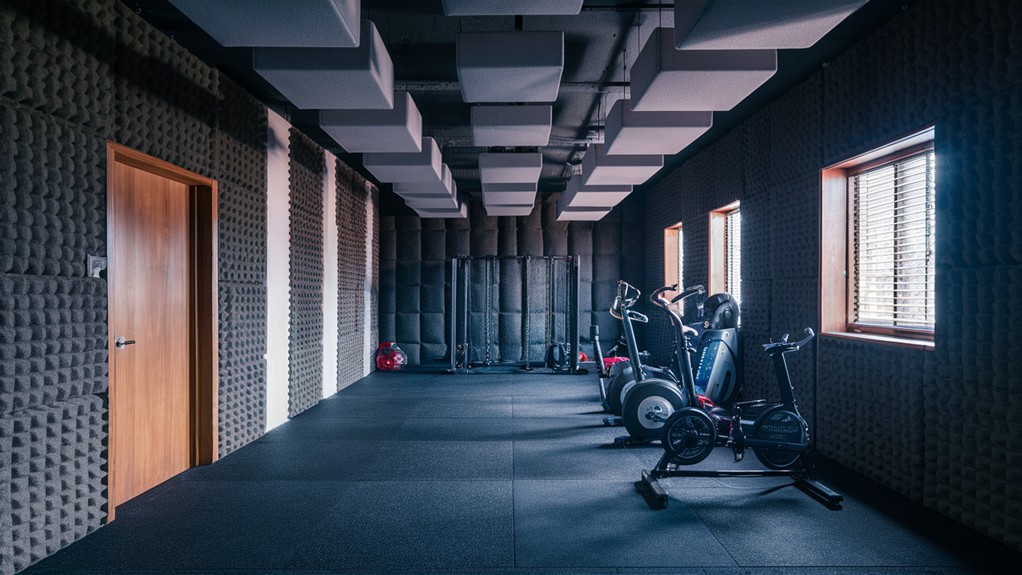To soundproof your training area, start by assessing the space and identifying noise sources. Install acoustic foam panels strategically on walls and ceilings, covering about two-thirds of the wall height. Use rubber flooring or thick gym mats to absorb impact noise and vibrations. Seal gaps around windows and doors with weather stripping, and consider upgrading to double-glazed windows and solid-core doors. Reduce equipment noise by using rubber-coated weights and silencer pads. Position heavy furniture against walls to block sound transmission. Don't forget to address HVAC noise by insulating ducts and using vibration dampeners. With these steps, you'll create a quieter, more focused training environment. Let's investigate each method in detail.
Assessing Your Training Space
Before diving into soundproofing your training area, it's crucial to assess your space thoroughly.
Start by evaluating the layout, paying close attention to how sound travels and identifying potential noise sources. This environmental noise assessment will help you determine the most effective sound insulation techniques for your specific situation.
Measure the room's dimensions, as larger spaces may require different strategies than smaller, enclosed areas.
Identify hard surfaces like concrete or glass that can reflect sound, necessitating acoustic treatments to absorb sound waves.
Don't forget to assess existing materials; carpet and fabric can help dampen noise, while metal and wood may amplify it.
Consider the proximity of your training area to common noise sources, such as busy streets or communal areas.
This information will guide your soundproofing needs and help you prioritize specific areas for treatment.
Acoustic Panel Installation
With your training space evaluated, it's time to tackle acoustic panel installation. Proper panel placement is essential for effective soundproofing. Start by positioning panels strategically on walls and ceilings, aiming to cover about two-thirds of the wall height. This placement guarantees optimal sound absorption across the room.
When selecting panels, consider their Noise Reduction Coefficient (NRC), which typically ranges from 0.5 to 1.0. Higher NRC values indicate better sound absorption. Choose panels made from materials like foam, fabric, or mineral wool, with thicknesses varying from 1 to 4 inches to target different frequency ranges.
For best results, use a combination of panel sizes and shapes to improve diffusion and absorption. This variety helps address a wider range of sound frequencies in your training area.
Installation techniques are key to maximizing panel effectiveness. Secure panels using adhesive, mounting brackets, or wall anchors, making sure they're evenly spaced for optimal coverage.
Remember to maintain consistent spacing between panels to prevent sound reflections.
Flooring and Underlayment Solutions
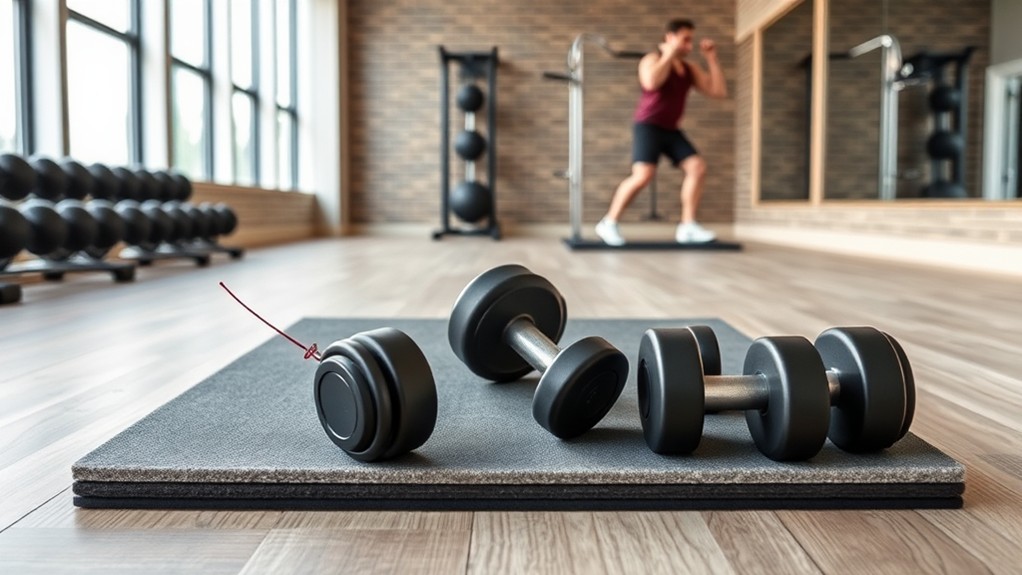
Choosing the right flooring and underlayment is crucial for soundproofing your training area. When selecting flooring types, consider rubber as your top choice. It's highly effective for sound absorption, greatly reducing impact noise and vibrations from exercises.
If you're working with heavy weights, opt for thicker gym mats, as they provide better sound insulation when weights are dropped.
For a versatile solution, interlocking foam tiles are an outstanding option. They're easy to replace or rearrange, offering both sound reduction and cushioning during workouts.
Don't forget about underlayment benefits; adding these materials beneath hard flooring can further diminish sound transmission.
Here are some key points to remember:
- Rubber flooring is ideal for general sound absorption
- Thicker gym mats are best for heavy weight training
- Interlocking foam tiles offer flexibility and easy maintenance
If you're using a treadmill, invest in a specially designed treadmill mat. These mats are effective at absorbing vibrations and preventing sound transfer to floors below, making your workouts quieter.
Window and Door Soundproofing
While proper flooring sets the foundation for a quiet training area, addressing windows and doors is just as essential for thorough soundproofing. Window treatments and door upgrades can greatly reduce noise transmission, creating a more peaceful environment for your workouts.
For windows, consider installing double or triple glazing. This upgrade can cut noise by up to 30 dB compared to single-pane windows. Complement this with acoustic curtains, which can dampen sound by an additional 7-10 dB. Don't forget to seal any gaps around windows using weather stripping or acoustic sealant to prevent sound leakage.
When it comes to doors, opt for heavy, solid-core options instead of hollow-core ones. This simple switch can reduce sound transmission by 20-25%. Add door sweeps to minimize sound passage under doors, effectively blocking sound waves from entering or exiting your training area.
Here's a quick reference table for window and door soundproofing:
| Window Solutions | Door Solutions |
|---|---|
| Double/Triple Glazing | Solid-Core Doors |
| Acoustic Curtains | Door Sweeps |
| Weather Stripping | Weather Stripping |
| Acoustic Sealant | Acoustic Sealant |
Equipment Noise Reduction Techniques
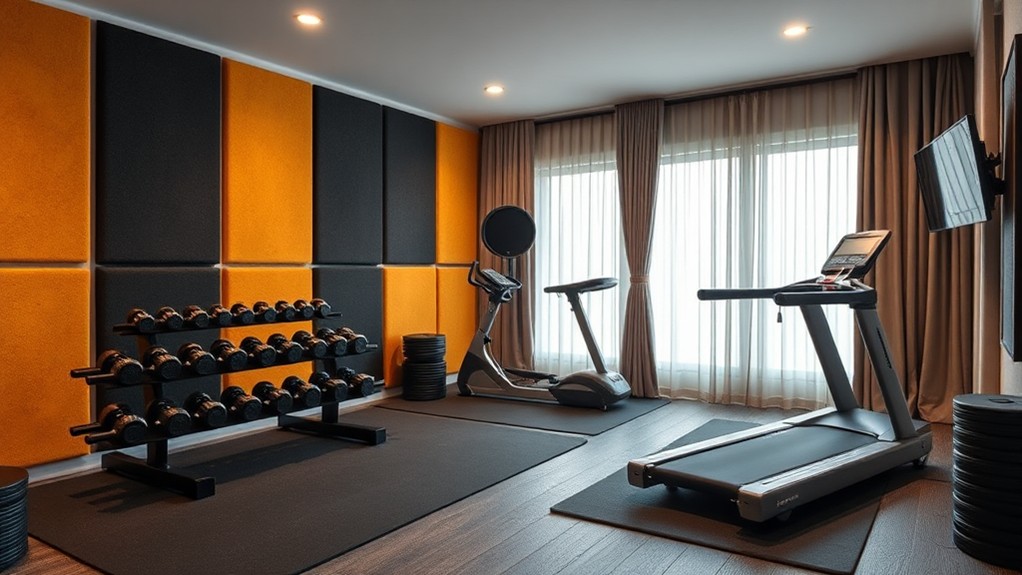
Equipment noise can be a major disruptor in your training area, but there are several effective techniques to minimize it. Start by focusing on weight selection, opting for rubber-coated weights and bumper plates instead of traditional metal ones. These absorb impact noise during lifts, greatly reducing sound levels.
To further improve sound absorption, apply silencer pads under heavy equipment. This will dampen vibrations and minimize noise when weights are dropped or moved.
Regular maintenance is essential for noise reduction. Clean and lubricate your gym equipment frequently to prevent squeaks and rattling. For metal surfaces, consider applying tape to absorb sound and minimize vibrations during use.
You can likewise incorporate quieter workout methods, such as resistance bands or bodyweight exercises, to reduce high-impact noise typically associated with traditional strength training.
Here are three key strategies for equipment noise reduction:
- Use rubber-coated weights and bumper plates
- Apply silencer pads under heavy equipment
- Regularly clean and lubricate gym equipment
Strategic Furniture Placement
Strategic furniture placement can considerably improve your training area's soundproofing efforts. By carefully arranging your furniture, you'll create effective sound barriers and boost overall acoustic comfort.
Start by positioning larger pieces, like bookshelves or cabinets, against walls. This furniture arrangement adds mass, helping to block sound transmission between spaces.
Next, focus on sound absorption. Incorporate upholstered furniture such as sofas and chairs into your layout. These pieces absorb sound waves, reducing echo and creating a quieter environment.
Don't forget about your training equipment; place heavier items near walls to minimize sound reflections and use them as additional barriers against noise.
To further dampen sound, place rugs or carpets under furniture. This prevents vibrations from traveling through hard surfaces, boosting acoustic comfort.
Consider using movable partitions or dividers to create designated training areas. These flexible solutions reduce noise spillover and help maintain focus during activities.
HVAC and Ventilation Considerations
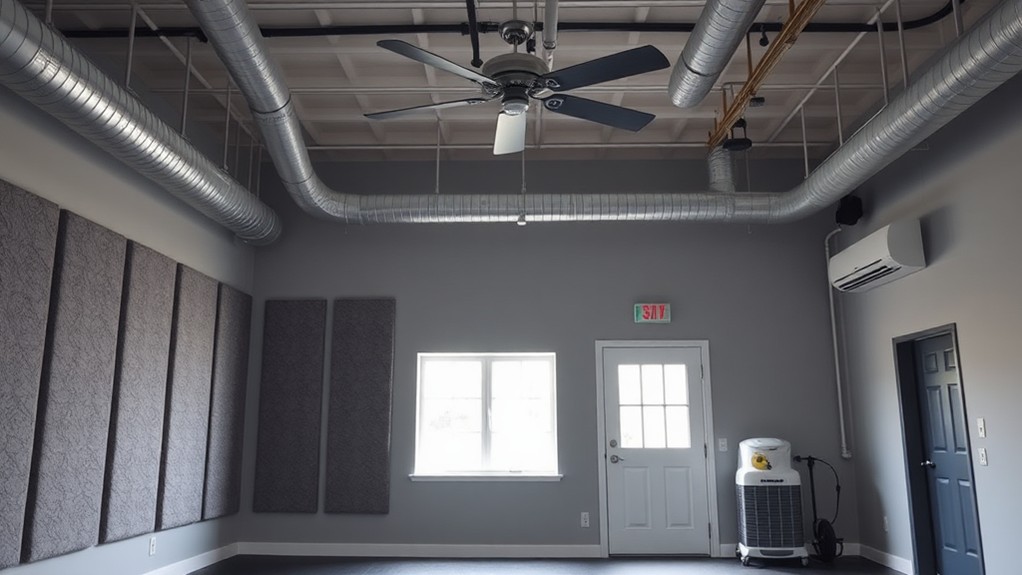
Have you considered the impact of your HVAC system on your training area's soundproofing efforts? Your heating, ventilation, and air conditioning setup can greatly affect the acoustic environment. By focusing on duct insulation and fan selection, you'll be well on your way to creating a quieter, more comfortable space for training.
To minimize noise from your HVAC system, consider these key strategies:
- Properly insulate ducts and use vibration dampeners
- Install sound-absorbing materials around ductwork
- Opt for variable speed fans in your HVAC system
Duct insulation plays a vital role in reducing noise transmission. By wrapping your ducts with sound-absorbing materials, you'll muffle the sounds of airflow and mechanical components. This simple step can make a world of difference in your training area's acoustics.
When it comes to fan selection, variable speed options are your best bet. They operate more quietly than traditional fixed-speed fans, giving you greater control over noise levels.
Don't forget to maintain your ventilation system regularly to prevent unwanted sounds from wear and tear. By implementing these HVAC considerations, you'll create a more peaceful and favorable environment for learning and training.
Soundproofing Materials and Products
Regarding soundproofing your training area, choosing the right materials and products is crucial.
Let's examine some effective options and their soundproofing benefits.
Acoustic Foam Panels
These versatile panels are excellent for absorbing high- and mid-range frequencies. You'll find them particularly useful in reducing total noise levels in your training space.
They're easy to install and can be strategically placed for maximum effect.
Rubber Flooring
Not only does rubber flooring provide comfort underfoot, but it likewise offers impressive sound absorption properties.
It's especially effective at minimizing impact noise from equipment, making it a smart choice for your training area.
Acoustic Curtains
If your training room has windows, consider hanging acoustic curtains.
They're great for dampening external noise and creating a quieter environment.
Plus, they add a touch of style to your space.
Sound-Absorbing Paint
For a low-profile solution that doesn't alter your room's design, try sound-absorbing paint.
It's an easy way to reduce sound transmission through walls and ceilings.
Isolation Membranes
Products like Acoustiblok can be installed in walls and ceilings to block airborne sound and minimize vibrations.
They're highly effective for improving total soundproofing in your training area.
Maintenance for Ongoing Noise Control
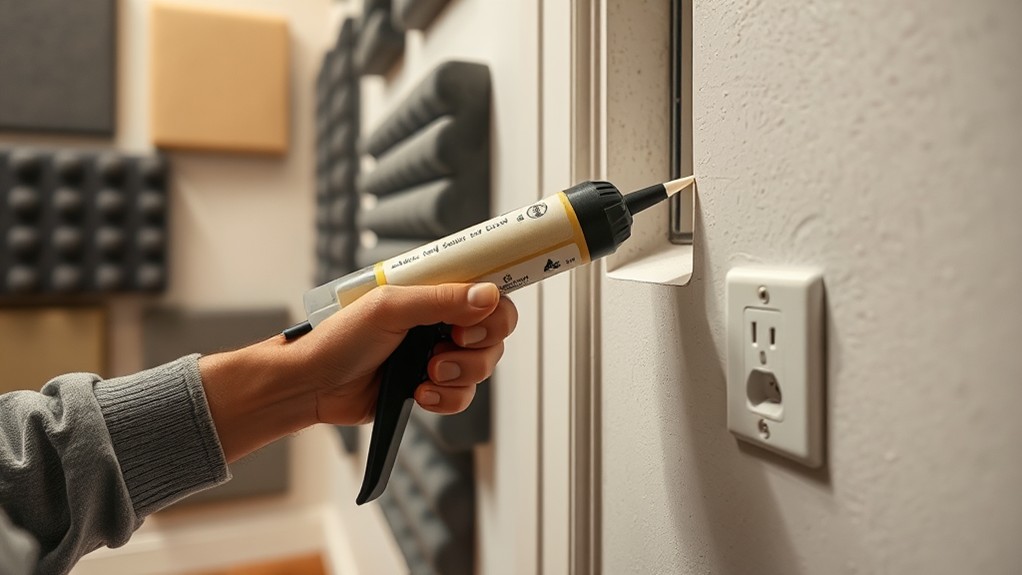
Once you've implemented soundproofing solutions, your work isn't over. Maintaining your noise control measures is vital for long-term effectiveness. Regular upkeep guarantees that your training area remains a quiet, considerate space for both you and your neighbors.
Seal integrity is a key factor in ongoing soundproofing. You'll want to perform routine inspections of your doors, windows, and any other potential weak points. Check for gaps, cracks, or worn-out weather stripping that could compromise your sound barrier. Replace or repair these as needed to keep sound contained.
Here are three important maintenance tasks to incorporate into your schedule:
- Clean and lubricate gym equipment regularly to minimize mechanical noise
- Assess and replace worn acoustic panels and soundproofing materials
- Maintain flooring materials, including rubber mats and underlay
Don't forget to periodically evaluate your comprehensive soundproofing strategy. As your equipment and usage patterns change, you may need to adjust your approach.
Frequently Asked Questions
How Do You Soundproof a Practice Space?
To soundproof your practice space, install acoustic panels for noise reduction. Add mass to walls, use sound-absorbing materials like carpets and curtains, and seal gaps around doors and windows. Don't forget to target specific frequencies with specialized treatments.
How to Soundproof From a Train?
To soundproof from train noise, you'll want to focus on vibration reduction. Install double-glazed windows, use acoustic barriers, and incorporate mass-loaded vinyl. Don't forget to seal gaps and add acoustic flooring to minimize sound transmission and vibrations.
How Do I Soundproof My Workshop?
To soundproof your workshop, start by installing acoustic panels on walls and ceilings. Use insulation materials like fiberglass in walls and floors. Don't forget to seal gaps around doors and windows. Add rubber flooring to reduce vibrations from equipment.
Do Soundproof Curtains Work for Trains?
Soundproof curtains can help reduce train noise, but they're not a complete solution. You'll notice some improvement in sound absorption, especially for higher frequencies. For best results, use them alongside other soundproofing methods to tackle persistent train rumbles.
